Not All Sweetness and Light: The Real Diet of Hummingbirds
Every birder knows that hummingbirds have a symbiotic relationship with certain wildflowers. Browse through any textbook about bird biology, and you will almost surely find a section detailing the connection—complete with photographs of the birds nectaring and diagrams of bills, tongues, stamens, pistils, and corollas. Because they are tubular and showy, and often red, the plants gain pollinators with long memories, who return to the same flowers again and again. And because their bills are long and their tongues flexible and grooved, the birds have access to energy sources not readily available to other animals. The birds probe the flowers to collect the nectar at the bottom of the corollas and come away dusted with pollen, which they carry from flower to flower. The birds are fueled; the plants are fertilized.
Hummingbirds and “hummingbird” plants make such an eye-catching ecology lesson that textbook authors repeat it in book after book, and birders often fail to see that it’s not the whole story.
What’s easy to forget is the proviso that most texts generally mention in a sentence or two but rarely illustrate: “Hummingbirds supplement their sugar diets by feeding on small arthropods.” Most of us know this truth, but my sense is that too many of us consider it a trivial point. How many birders have made a determined effort to watch how hummingbirds feed themselves away from flowers? And how important is that supplement, anyway?
One problem may be that we don’t know what to look for. In a fairly lengthy library and Internet search, I found few illustrations of arthropod-hunting by hummingbirds (although it’s easy to find photographs and drawings of the much rarer activity of hummingbirds being killed by praying mantises). The oldest explanatory images I could find dated to 1946 and appear in an article by German ornithologist Helmuth O. Wagner titled, “Food and Feeding Habits of Mexican Hummingbirds,” published in The Wilson Bulletin.
Wagner studied the foraging behaviors of more than a dozen species in Mexico during the 1940s. He illustrates the techniques used by starthroats, sabrewings, violet-ears, and other hummingbirds to capture flying insects from the treetops, over cornfields, and above forest streams. Several hummers are drawn in silhouette flying up from tree branches to snatch insects from the sky, kingbird-style—a foraging technique that today would be called sally-hawking. He also describes hummingbirds gleaning prey from bark, leaves, and even water surfaces.
Based on his field observations, his work with captive hummingbirds, and the stomach contents of collected specimens, Wagner concluded that insects and spiders were far more important in hummingbird diets than is generally understood and that nectar was not as essential as many authorities believed. Hummingbirds adapt their foraging to whichever sources are available, and arthropod prey often replaces nectar. “The food of hummingbirds is determined primarily by habitat and season,” he wrote. “A given species may feed mainly on nectar or mainly on insects, depending on the time of year. The majority of the hummingbirds in Mexico are not dependent on flowers.”
Although few researchers have claimed that hummingbirds can go without nectar indefinitely, a number of them have argued that arthropods are more important in the birds’ diets than is generally supposed. A 1980 study published in The Condorinvolved just a single individual hummingbird, but it is frequently cited. Robert D. Montgomerie and Catherine A. Redsell tracked the foraging activities of a female Broad-tailed Hummingbird for two weeks in May in and around her nest in Rose Canyon in Arizona’s Santa Catalina Mountains. The researchers surveyed for nectar plants in the nearby landscape (in a one-kilometer-diameter circle around the nest) and found none in bloom that were appropriate for hummingbirds. Over several subsequent days, they recorded time budgets for the female’s activity for 10-minute intervals during each daylight hour (6:00 A.M. to 8:00 P.M.) and followed all her movements away from the nest as best they could. “During the 19 foraging bouts…that we observed,” they reported, “the hummingbird spent all her time either flycatching, gleaning from leaves, probing among lichens on tree trunks, or flying between foraging sites.” Their conclusion: “[T]he bird must have subsisted only on arthropods for at least two weeks.”
A much larger study by J. V. Remsen, F. G. Stiles, and P. E. Scott published in 1986 in The Auk examined the stomach contents of more than 1,600 individuals of 140 species of tropical hummingbirds and found that 79 percent held arthropod remains. “The data indicate that most hummingbirds, at any given moment during the day, are digesting arthropods [and suggest that] most hummingbirds feed on arthropods on a daily basis and probably at regular intervals throughout the day.”
Why don’t we notice hummingbirds hunting more often? Could it be that they spoil us—chasing each other through our yards, preening in the open on leafless perches, or, best of all, zooming right up under our noses to nectar at our feeders and garden plants? In those situations they make themselves hard to miss. Hunting for insects, however, they seem to keep a lower profile, noted often only by those who are most alert.
In a report published in The Condor in 1995, summarizing his 18 years of hummingbird observations in the lowland forest in La Selva, Costa Rica, F. G. Stiles describes and illustrates four primary methods tropical hummingbirds use to capture arthropods. Do temperate-zone hummers use the same?
The first method, hover-gleaning, looks like nectaring: the bird holds itself in the air a few inches from a spider web or a leaf and reaches for the prey with bill and tongue. This may be the most easily observed of the four methods. If you witness this behavior, you might try to determine the bird’s target—sometimes it’s the spider, but hummers also parasitize from the webs, taking insects the spider has already captured. (And, of course, female hummers often steal the threads from webs as adhesive building material for their nests.) A second method, hover-hawking, also involves hovering, but here the bird zigzags through swarms of insects, picking them off one by one, almost as a swallow might. The final two methods are probably the hardest to notice because both involve the bird sitting quietly and mostly motionless, scanning for prey. In sally-hawking, the bird flies up to snatch a single flying insect and then returns to its perch. In sally-gleaning, the hummer flies up to pick an insect off a leaf and returns to perch.
Stiles’ superb and lengthy article cannot be summarized adequately in the space available, but here are a few highlights:
More than half of all foraging efforts Stiles recorded (both nectaring and predation) involved hunting for arthropods. Nectaring is actually the less-frequent activity.
Hawking is more frequent higher in the vegetation; sally-gleaning and hover- gleaning are more common at lower heights. Foraging activity of all types is most intense early in the morning, when the birds are at their hungriest.
Spiders are a favored prey among many species; some tropical hummers feed almost exclusively on them. Stiles even noticed some spiders retreating from their webs when the birds hovered near, and he suggests this might point to a competitive advantage for hummingbirds with longer bills, which can still probe and grab without alerting their prey by the whir of their wings.
During the nesting season (at La Selva at least), females spend three to four times more time searching for arthropods than males do. In fact, the importance of arthropod foraging may be one reason why female hummers in many species—including several North American species— have longer bills than their mates. In all hummingbirds, females are the sole caretakers of their nests and young, obligated to gather all the food for their nestlings, which need protein for growth.
Can observers equipped only with binoculars study these phenomena? The answer is an unqualified yes. Stiles depended extensively on his visual observations of birds in action in compiling his data, as did Wagner in the 1940s, when binoculars were much weaker instruments than they are today.
Searching them out away from our feeders is one key, of course. That involves a little extra legwork. As is the case in many other birding challenges, however, the real challenge is mental: to learn how these birds truly live their lives, we must make the effort to look past their flash and dazzle to the grittier reality just beyond.
What Do Hummingbirds Eat?
The hummingbird (a family comprised of more than 300 species, found mostly in the tropics but distributed worldwide) is among nature’s most talented flyers. Beating their wings up to 90 times a second, these amazing birds can complete deft aerial maneuvers and even fly backward without a hitch. In order to execute these physically demanding flights of fancy, however, their heart rate can easily reach more than a thousand beats per minute. As a result, they need a diet very high in concentrated energy to support their active lifestyles. People often leave out hummingbird birders in their yards to attract these magnificent and colorful creatures.
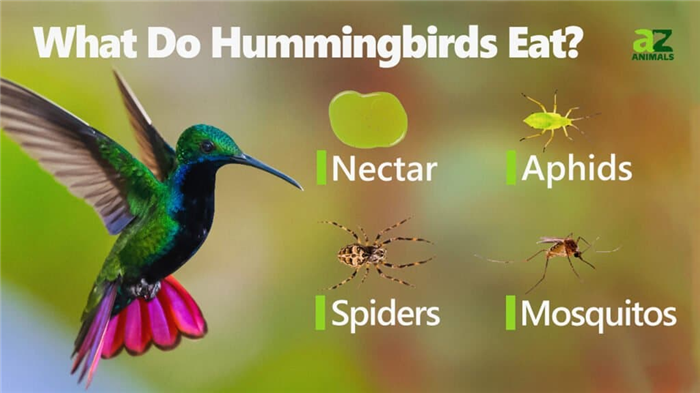
Hummingbirds eat nectar, aphids, spiders, and mosquitos.
The hummingbird is best described as a true omnivore. It requires a steady source of flower nectar, supplemented with plenty of arthropods (insects and spiders), to support its frenetic activity. When in flight, the hummingbird has the highest metabolic rate of any known animal. When they’re not flying (around 70% to 80% of the time), the hummingbird often enters a state of deep sleep in which its heart and breathing rate slows to conserve energy and digest food. It can eat anywhere between half and twice its body weight in food per day.
2,239 People Couldn’t Ace This Quiz
Think You Can?
The ratio of nectar to arthropods can change quite a bit depending on the season and the habitat in which they reside. Based on a study of their stomach contents, hummingbirds may be more dependent on arthropods than once believed. Arthropods are an important source of protein and in some cases may comprise their main source of food.
Hummingbirds are not fruit eaters, but sometimes, they will take advantage of the situation created by the sapsucker, a type of woodpecker that drills rows of holes in trees to feed on the sap contents within. The tree sap just happens to mirror the sugar content found in nectar and therefore provides a good alternative food source. Some hummingbirds will even follow the sapsucker from tree to tree as they release the sap hidden within.
What do Hummingbirds Eat in the Winter?
Many northern species of hummingbirds migrate south in the winter. This allows them to maintain a similar diet that they enjoy during the spring and summer: a combination of flower nectar and arthropods. They don’t really have a specific diet in the winter though.
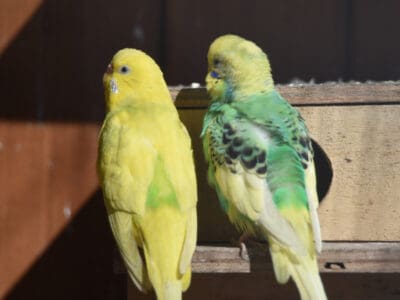
The Best Nest Boxes Birds Will Actually Use for 2022
What do Baby Hummingbirds Eat?
Baby hummingbirds mostly eat the same foods as their adult counterparts. When the parents return with a mixture of nectar and arthropods, they will regurgitate the food into the open mouths of their young. It usually takes at least three weeks until the baby birds have fully-fledged and begin to hunt on their own.
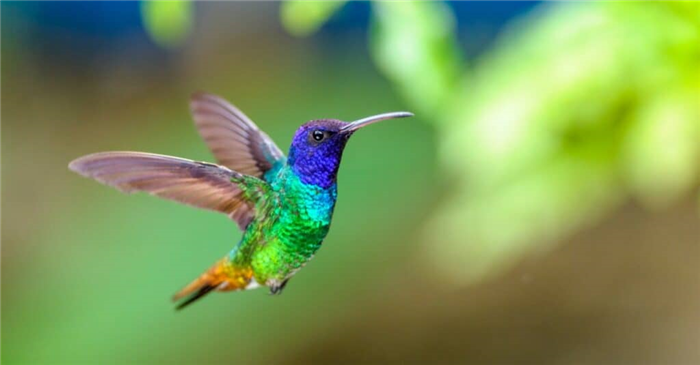
Hummingbirds beat their wings up to 90 times per second.
Hummingbirds have evolved a highly dependent relationship with the local flowers in their ecosystem. Their bills are specially shaped so they can scoop nectar directly out of the base of the flower. Some beaks are so strange and exaggerated in their curvature that they could have only adapted for a specific type of flower. In return for this nectar, hummingbirds help the plants pollinate by carrying pollen as they move from one food source to the next. The pollen will often become lodged in their beaks as they drink.
Most of the flowers that they frequent are normally colored in some shade of red, orange, or pink to provide a visual cue (other colors are possible as well). Hummingbirds are very good at assessing the sugar content of nectar and will reject any flower that does not meet their high standard. When they drink, the hummingbird will open its bill slightly and lap up the liquid with its narrow tongue. The nectar is so important to the bird’s survival that it will sometimes protect its food source from intruders.
It may be somewhat surprising, then, that these highly specialized nectar feeders are also very adept at hunting insects and spiders. They deploy multiple types of hunting strategies. One strategy is called hover gleaning. This occurs when the bird hovers a few inches from a food source (such as a spider web or plant) and captures the prey with its beak and tongue. Another method is called hover hawking. This occurs when the bird flies rapidly through a swarm of insects and picks them off one by one. The hummingbird also has the ability to wait patiently on a perch and then swoop down to pick off prey.
What Insects do Hummingbirds Eat?
The answer to that question really depends on where they live. Hummingbirds usually enjoy some combination of ants, fruit flies, beetles, aphids, mosquitoes, weevils, gnats, and other types of insects. They also like to pick off insects caught in spider webs, sometimes even consuming the spider in the process. They tend to avoid dangerous stinging insects such as bees that may compete for similar food sources.
Nectar appears to be their main source of food, but recent studies have revealed hummingbirds actually consume vast quantities of spiders and even some insects as well. Perhaps as much as 80% of their diet can be meat-based.
What can I Feed Hummingbirds Besides Sugar Water?
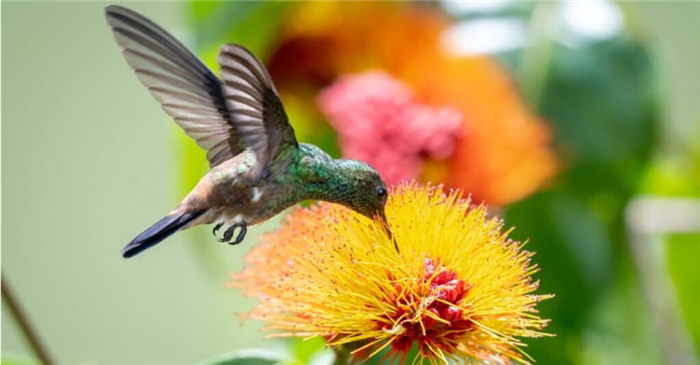
Hummingbirds generally eat nectar from flowers that are a shade of red, orange, or pink.
Refined sugar water seems to be the best thing you can feed them, but honey sometimes works as well. Artificial sweeteners should be avoided; they may have ingredients that could prove harmful to the bird. Other than that, there’s really nothing else you can feed them. Hummingbird feeders filled with sugar water should always provide a suitable meal for the bird; the only downside to an artificial feeder is that it does prevent them from engaging in their natural behavior of spreading pollen between flowers.
A Complete List of the Top 10 Foods the Hummingbird Eats
The hummingbird is a highly unusual eater. It tends to be very picky about a single source of food (nectar) and not very picky about its choice of other foods. This list should give you an idea of how many types of insects it can consume.
- Nectar
- Sap
- Spiders
- Aphids
- Weevils
- Mosquitoes
- Beetles
- Fruit flies
- Ants
- Gnats
Share this post on:
AZ Animals Staff
AZ Animals is a growing team of animals experts, researchers, farmers, conservationists, writers, editors, and — of course — pet owners who have come together to help you better understand the animal kingdom and how we interact.
What Foods Do Hummingbirds Eat?

Melissa Mayntz is a bird expert, certified Master Naturalist, writer, and author with over three decades of experience. She’s published in several national magazines, including National Wildlife Magazine, Bird Watcher’s Digest, and WildBird Magazine. Melissa has studied hundreds of bird species around the world, traveling to Mexico, Central America, the Caribbean, the central Pacific, the Middle East, and more on birding expeditions.

Sarah Scott is a fact-checker and researcher who has worked in the custom home building industry in sales, marketing, and design.
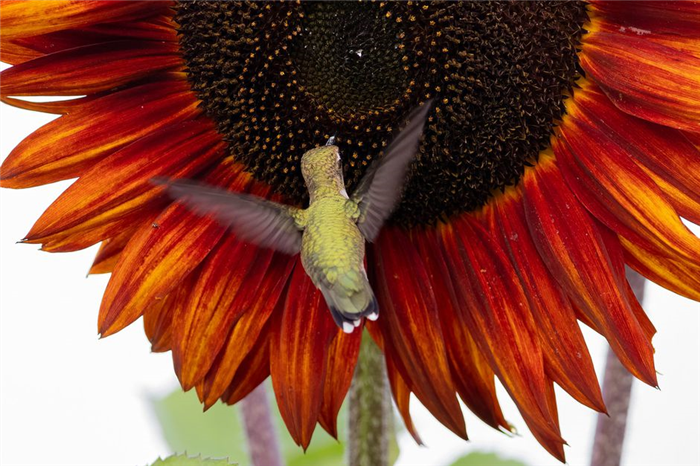
The Spruce / jskbirds
All backyard birders know that hummingbirds drink sugar water, but what else do hummingbirds eat? Understanding what food sources hummingbirds like best can help you plan an attractive backyard buffet that will tempt these tiny birds as well as meet all their nutritional needs.
Watch Now: 9 Incredible Hummingbird Facts
Hummingbird Nectar
Nectar, either from suitable flowers or sugar water solutions, is the most abundant and popular source of hummingbird food. The large amount of sucrose in nectar gives hummingbirds the necessary energy for their high metabolism, swift flight, and energetic lives.
Because nectar is liquid, it also supplies the birds’ necessary water, and hummingbirds do not typically drink from other water sources. Nectar does not, however, meet hummingbirds’ needs for protein, amino acids, and different vitamins and minerals, and they must eat other things to have a balanced and healthy diet.
To make hummingbird nectar, follow a precise recipe. Mix 1 cup sugar (refined white sugar) with 4 cups water until the sugar dissolves. Do not add any dye or other additives into the mixture. Any extra sugar water can be put in your refrigerator for use in the feeder in the next few days.
Hummingbird Diet
In addition to nectar, hummingbirds eat a variety of other items to get adequate nutrition.
Insects
Small insects, larvae, insect eggs, and spiders are critical food sources for hummingbirds. Insects provide the fat, protein, and salts the birds cannot derive from nectar, and these are crucial nutritional components, especially for rapidly growing hatchlings.
Hummingbirds may hunt insects in several ways, including gleaning or picking them from bark, flowers, or leaves; hawking them in midair; or plucking them from spider webs or sticky sap.
To get the required amount of protein for a healthy diet, an adult hummingbird must eat several dozen insects each day. They will eat many more, however, if they need to regurgitate this nutritious food to hungry hatchlings, or if they are in the midst of a long migration.
When nectar is scarce, hummingbirds will sip tree sap from wells drilled by woodpeckers. While the tree sap is not as sweet as floral nectar, it still provides an adequate source of sucrose for a hummingbird’s energy needs. Sap that has dripped down and hardened on the tree trunk cannot be drunk, but the birds may pick insects from the sticky residue.
Pollen
Hummingbirds do not directly consume pollen, but a great deal of pollen can be stuck to their tongues and bills when they sip nectar from flowers. Some of that pollen is ingested, and it can be a minor source of protein even though it wasn’t directly eaten. However, less than 10 percent of the ingested pollen is actually digested. This shows that, while viable, this is not a common food source for hummingbirds.
Ashes and Sand
Some hummingbirds have been observed eating ashes and sand in small quantities. These foods can be a good source of vital minerals and salts, but not much is needed to fulfill a hummingbird’s dietary needs.
It is also possible that the birds were picking insects from the material, rather than actually eating the ashes or sand. More close observation and study are needed to determine how critical this food source may be for hummingbirds.
Fruit
Certain ripe or juicy fruits may attract hummingbirds. Hummingbirds have been known to discreetly sip the juices from berries, apples, pears, and oranges if they are peeled, cut open, or if the flesh is otherwise exposed.
Attracting Hummingbirds With Food
Understanding what hummingbirds eat will help you plan a backyard feeding station to sate hungry hummers. To attract hummingbirds with the right types of food, consider the following:
- Plant native flowers and flowering shrubs and trees that produce nectar-rich blooms, including honeysuckle and coral bells. Red, tubular flowers will attract the most birds, and choosing hummingbird flowers that bloom throughout the season will ensure an adequate nectar supply for months. Consider removing flowers hummingbirds don’t like and replacing them with better nectar-producing blooms instead.
- Avoid spraying for insects or spiders in the garden or around your home, and do not knock down webs or otherwise disrupt the insects. Rely on hummingbirds and other insect-eating birds to provide natural pest control instead.
- Use hummingbird feeders filled with a proper sugar solution to simulate natural nectar. Red feeders will attract hummingbirds, and a hummingbird nectar recipe of four parts water to one part sugar is closest to the sucrose levels of the most popular flowers. Do not use honey, molasses, fruit juice, or artificial sweeteners to make hummingbird nectar, as none of them are adequate and some could be dangerous to the birds.
- Provide nearby perches for hummingbirds to defend their favorite feeding areas. Many hummingbirds are extremely territorial, and they will use a perch as a lookout point for intruders. If they feel comfortable in the area, they will stay nearby and feed more easily.
Hummingbirds may be popular summer visitors at nectar feeders, but they eat many other things. Just as a good backyard feeding station will provide different types of birdseed and other suitable foods, providing different hummingbird foods ensures that these beautiful birds never leave your yard hungry.
The Spruce uses only high-quality sources, including peer-reviewed studies, to support the facts within our articles. Read our editorial process to learn more about how we fact-check and keep our content accurate, reliable, and trustworthy.
Suarez, Raul K, and Kenneth C Welch. Sugar Metabolism in Hummingbirds and Nectar Bats. Nutrients, vol. 9, no. 7, pp. 743, 2017. doi:10.3390/nu9070743
Brice, A.T. et al. Pollen Digestibility by Hummingbirds and Psittacines’. The Condor, vol. 91, no. 3, pp. 681-688, 1989, The Cooper Ornithological Society. doi:doi.org/10.2307/1368120
What Foods, How Often and How Much Do Hummingbirds Eat?
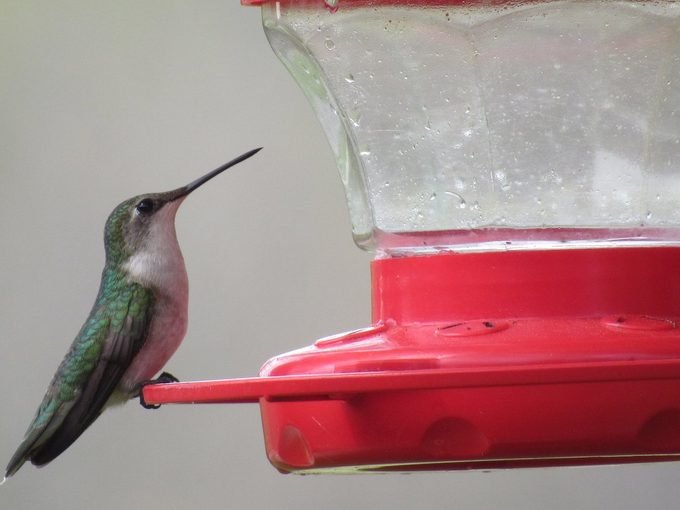
If you want to attract these majestic fliers, you need to know what foods hummingbirds eat. Hummingbirds consume a variety of foods in their diet. They drink nectar from flowers and sugar water for energy. Roger Emerick of South Glastonbury, Connecticut, asks, “Should I add anything to the sugar water for my hummingbirds to make it more nutritious?”
When you’re feeding them at your hummingbird feeder, there’s no need to put in additives such as red dye or honey. Offer hummingbirds the perfect meal by making this sugar water recipe.
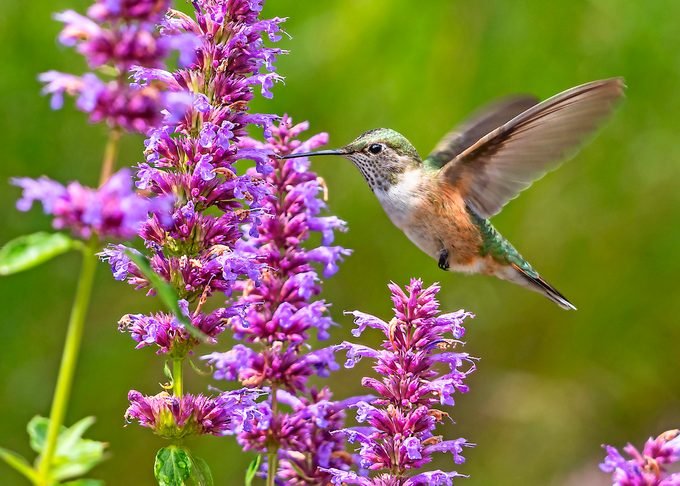
Nectar-rich tubular flowers are another way for backyard birders to lure hummingbirds to eat in your backyard. Bee balm, salvia, coral honeysuckle and fuchsia are popular flowers with hummingbirds, offering the vibrant colors they love and easy access to nectar. However, the sweet stuff covers just one dietary need. Hummingbirds forage for other food sources besides flowers and feeders.
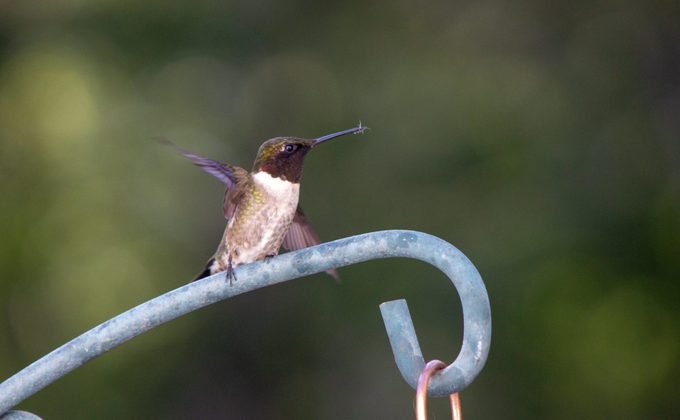
Do Hummingbirds Eat Mosquitoes?
Hummingbirds also require protein to survive. They get their fill of it by eating small insects like fruit flies, mosquitoes and gnats. They eat spiders, too. Multiple food sources like sugar water, flowers and bugs are especially important as baby hummingbirds seek nutrition and prepare for fall migration.
Hummingbirds are so resourceful that they often forage for insects in the sap wells drilled in trees by sapsuckers.
Like many other hummingbirds, Anna’s eat insects like midges and leaf hoppers. The high-protein diet might help them tolerate colder conditions in gardens, parks and streamside areas all along the West Coast year-round. Allen’s hummingbirds pluck bugs and spiders off spiderwebs.
How Often Do Hummingbirds Eat?
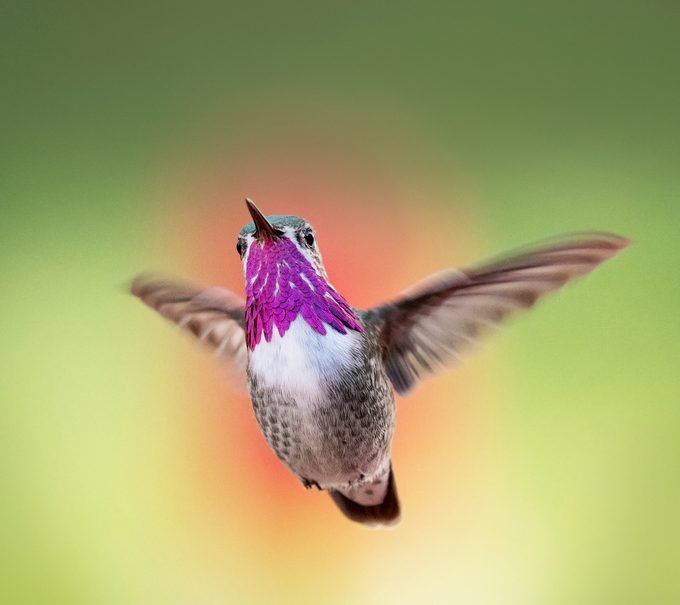
Courtesy Elijah Gildea
Because they constantly burn energy while on the move, hummingbirds may eat up to three times their body weight in a day. To find that much nectar, one bird might visit hundreds of flowers per day. This is why a hummingbird-friendly backyard is so important.
Anusha Shankar, a postdoctoral fellow conducting research at the Cornell Lab of Ornithology, explains why these birds are always eating. She says, “Hummingbirds need to eat constantly because they use up energy very quickly. If we had their metabolic rate, we’d need to eat 300 hamburgers a day to survive!”
Hummingbird fans will delight in these hummingbird-themed home decor items.
How Much Do Hummingbirds Eat?
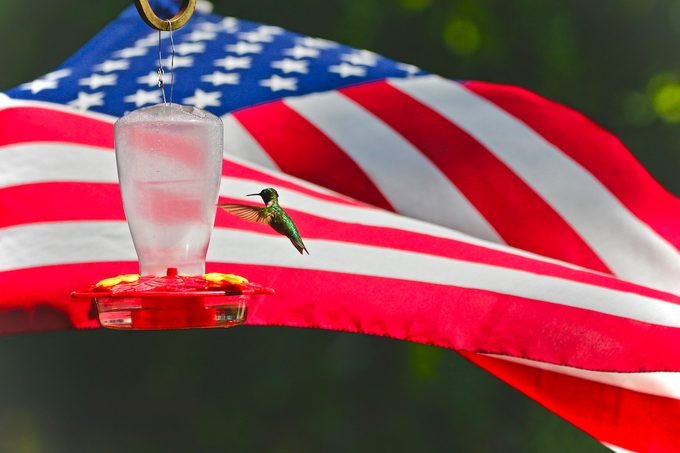
“I use about a gallon of sugar water a day. Is it possible to determine how many hummingbirds I feed by the amount of sugar water they drink in a day?” asks Marge Kaufman of Sigel, Illinois.
According to lab studies, the amount of sugar water consumed by a hummingbird will vary depending on the richness of the sugar concentration. With the typical 4:1 ratio of water to sugar, a ruby-throat probably won’t drink more than about 2 fluid ounces per day. A gallon of sugar water could feed about 60 hummingbirds in a day! The actual number of individuals could be even higher if some are just stopping briefly, or it could be lower if some of the sugar water is being lost to evaporation, dripping, insects, etc. It’s tricky to come up with solid numbers, but it’s still fun to ponder how many hummers might be out there.
Birds & Blooms reader Elijah Gildea of Redding, California, writes, “Every spring and throughout most of the year, 50 to 100 hummingbirds visit my 11 feeders. They drink about 2 gallons of sugar water per day! April is my favorite month. I’ve had as many as six species show up then—Anna’s, rufous, Calliope, black chinned, Allen’s and a single Costa’s.”
Final Thoughts
I always knew that hummingbirds drank nectar, but when I first learned that they also eat lots of insects and spiders, I was a little relieved! I was worried about their diet of sugar water and wanted to make sure they got some other nutrition. 🙂
The fact that hummingbirds follow sapsuckers around hoping to drink some of the sap they drill from trees was incredibly fascinating. I have never observed this, but now I have something new to look for while out in the woods.
